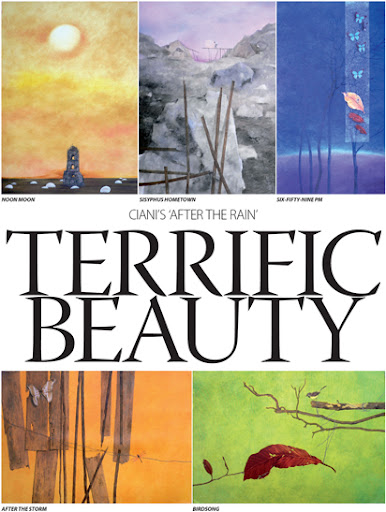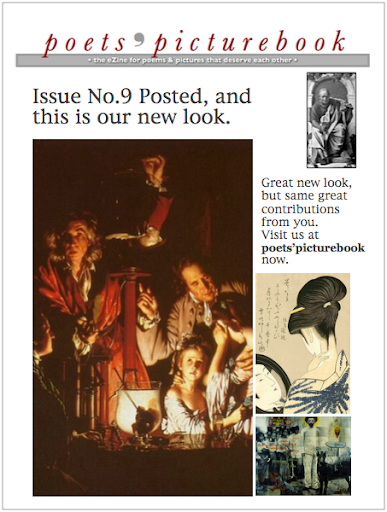
 NOON MOON(clock wise), SISYPHUS HOMETOWN, SIX-FIFTY-NINE PM, BIRDSONG, AFTER THE STORM
NOON MOON(clock wise), SISYPHUS HOMETOWN, SIX-FIFTY-NINE PM, BIRDSONG, AFTER THE STORMBy Tito Genova Valiente
titovaliente@yahoo.com
ONGOING at the Galeria Duemila is an exhibit featuring the works of two artists: a painter and a poet. Lina Llaguno Ciani is the painter and Marne Kilates is the poet. The preoccupations of these two individuals might as well be considered interchangeable considering that poems paint images, while paintings bring in the poetics of that who wields the brush.
Ciani is a noted Bicolana painter, from Albay, who has produced a series of paintings representing what she felt after seeing her hometown and province following the floods caused by Typhoon Reming. Ciani believes “gloom is not perpetual.” This is coming from an artist whose works have been described by critics as surrealism without angst. For this show, she has invited Kilates, a Bicolano whose poems are marked by their daring incursions into the potency of words to suggest alternative spaces, or to plumb the world of myths where words open paths and light the way to more narratives.
The usual expectation from this tandem is for the words of the poem to traditionally repeat the points visualized on canvas, with the requirements of reading and understanding immediately relegated to a subordinate art or exercise in communication. In the hands and minds—and hearts—of these two artists, however, something else has been accomplished. Perhaps, it is the sharing of ethnicity and geography and the shared memories that go with such alliance. Perhaps, it is being an audience to Nature running berserk and coming back full circle into its nonthreatening origin. Whatever it is, the exhibit is a demonstration of two artists in a conversation, not in a feedback relation.
To Ciani’s leitmotif of eggs, strings, birds, flowers and the solitary figure of a woman, Kilates—agreeing with the painter about the pieces to be addressed through a poem—brings in lines detailing things that have happened in the past, and promising to happen again in the future. In both selected painting and poem, you can smell the scent of wistfulness. An overpowering anxiety of silence has its temporal equivalent in the massive blankness of the spaces created, not left to chance, by the painter.
In the ‘Noon Moon’, the famed belfry of Cagsawa, an icon to a more ancient destruction of Mayon Volcano, is reburied again. Looming above it is a sun too muted to be a sun that it has become the moon. Around it are white spherical shapes. Are they eggs of a mighty serpent? Kilates picks the pun of the landscape and writes about the bakunawa, the Moon Eater. The play does not terminate with words for the poet seizes the forbidding puslike yellow sky and the absence of living things and asks us to Beware of his beauty because/He has never been beautiful:/Ghostly serpent slinking in a circle…/.
The poet composes three tanaga, a convention often compared with the Japanese haiku. A seven-syllable quatrain, the tanaga renders itself crucially well in three paintings dominated by a tree. One tree has its twigs and branches bent to one side by a strong wind even as they seem to balance numerous eggs on its nonexistent crown. From this tree an egg has already fallen as the poem talks about In purple air everything swirls,/Life hangs or clings like eggs or pearls…. The picture is dramatic and superliteral and the poem pushes its literalness, achieving in the double negative a positive way of looking at destruction. The other tanaga is for a tree almost shrouded in an orange that is organically scary. The twigs and the branches this time are home to tiny butterflies metamorphosed into eerie loveliness.
Breathtaking is the painting labeled ‘Six-Fifty-Nine PM’ and there are solid reasons behind its beguiling force. There is the painting itself, which evokes the simplicity of a card that memorializes an event. The field is dominated by funereal purple and the saddest of blues. A strip of transparent pastel white-blue field appears embossed on the upper right-hand corner and carries butterflies (or moths) and brown rotting leaves, a compendium of the living and the dying and the dead. Then comes the tanaga that is both an elegy and a thanksgiving: Grave visits us like moth and leaves,/The rain drumming on roof and eaves./Always, God has something up His sleeve:/Mists and colors after nature grieves./. That’s what the poet says, but the painter returns the metaphor for she also has some tricks up her sleeves. In that strip containing the artifacts of the storm lives on a kakejiku, the Japanese scroll that incorporates a poem with the kana or syllabaries flowing down on one side, a form where image and words are fused in one endearing agreement or even dissonance.
There are more paintings that are not displayed with poems. It is to the credit of these two artists that the poems can be read and enjoyed outside the galleries, and the paintings—all of them—can terrify, or exalt our fear and incite us to hope even without words or poems.
‘After the Rain’ is the 34th show for Lina Llaguno Ciani, an artist schooled in the University of the Philippines-School of Fine Arts and the Academia delle Belli Arti in Perugia, Italy. Marne Kilates was the 1998 Southeast Asia Write Award (SEA Write) recipient, an award bestowed by the Thai Royalty to honor outstanding writers in the region. He has also won several awards, among them from the Don Carlos Palanca Memorial Literary Awards and the Manila Critics Circle’s National Book Awards. The show runs until February 29 at Galeria Duemila, on 210 Loring Street, Pasay City.
TITO GENOVA VALIENTE is a poet who has been a long-time scholar in Japan. We crossed paths when we were both working with the old NFA Directorate for Public Affairs and somehow lost track until we saw each other's bylines again.



No comments:
Post a Comment